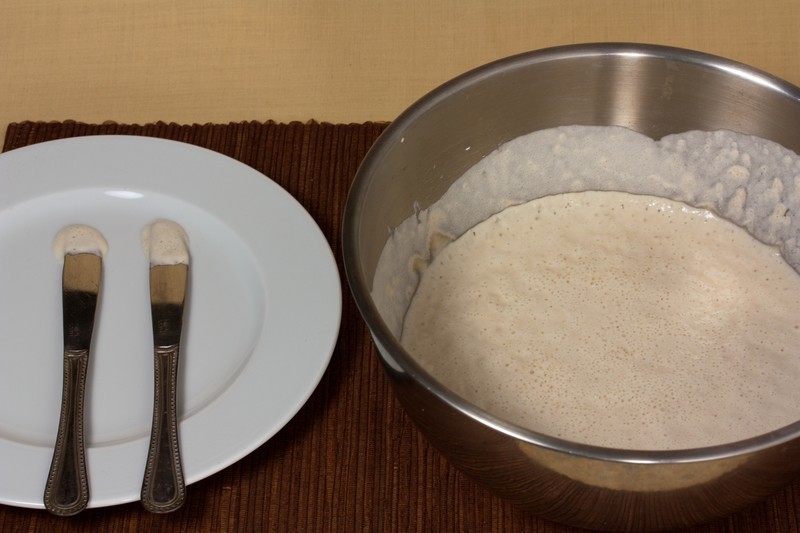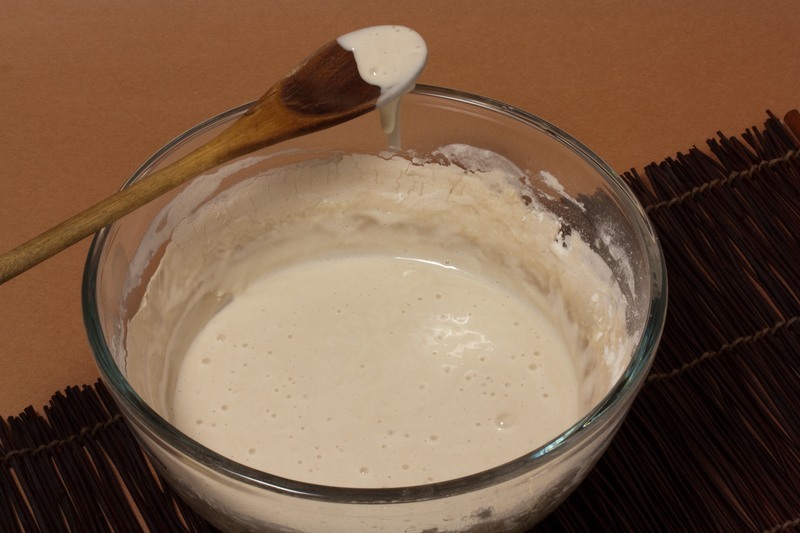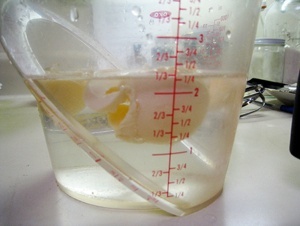How To Make a Wild Yeast Starter
3
Comments (16)

Having a wild yeast starter (also known as a sourdough starter) in your possession can lead to a whole new wold of fascinating flavors and food experiences. Everything from breads, pancakes, quick breads to pizza crusts can be made with wild yeasted dough, which has no need for commercial bread yeasts. Think of it as your magic little dough friend that's actually alive, waiting to morph into and enhance whatever you introduce it to.
Find Wild-yeasted recipes on Veganbaking.net
A Little Sourdough History
Back in the good old days, from at least as early as Egyptian times to the late 1800s, all bread was wild yeasted. The term wild yeasted is interchangeable with sourdough. It's meant to describe a mixture of flour and water that has been set aside to accumulate naturally occurring yeasts and bacterias to allow the bread ferment, which causes it to rise, or leaven. When people made bread in early times they used a little of the dough from the last batch to start fermenting the dough of the next batch.Using yeast to rise bread has been depicted in ancient Egyptian hieroglyphs. Someone probably left a water and flour mixture out a little too long and it gave the bread a more fluffy texture with more flavor complexity. We have been spending at least the last 5000 years still trying to perfect our breads. In early times no one knew how or why bread was leavened. It wasn't until the 17th century that the microscope was invented and we could finally see what was happening on the cellular level. In the mid 1800's there was fierce debate on the cause of leavening, some claiming that it was due to a breakdown of cells, others claiming it was due to living organisms.
It wasn't until 1857 that Louis Pasteur solved the mystery by determining that the white powder on grape skins called bloom was actually yeast spores that caused wine to ferment. This proved that fermentation was caused by a living organism. After all these years we finally knew what caused our bread to rise and everyone let out a collective “eeeeww”. This sparked fear into the minds of many people and a movement was started to move away from sour breads because they were likened to decaying matter.
Bread bakers then began making breads from leftover yeast from beer brewing. To this day, bread yeast is the same as beer yeast. Bread yeast is actually called Saccharomyces cervisiae. Cervisiae translates to “of beer” in latin. But all of this yeast making was starting to get tiring. What if there was an easier way to just make the yeast?
In the late 1800's Austrian chemists figured out how to make what we know today as commercial bread yeast. This changed everything because now you could just add yeast to bread as an easily measurable ingredient. The advantages to this is that many aspects of bread such as flavor, rise and lightness could be easily controlled and calculated, leading to more consistent bread that was easier and cheaper to make. This also ushered in what I call “the dark ages of bread”. Wild yeasted bread began to be shunned by the higher class because bread made from commercial yeast had a less complex, cleaner flavor and was thus associated with higher quality. This led to a downturn in the production of wild yeasted breads much in the same way that whole wheat breads were originally more popular amongst the lower classes.
Wild Yeast Explained
Why does wild yeasted bread have such a complex flavor compared to bread leavened with commercial yeast? I thought you'd never ask! When flour and water are left out for several days, naturally occurring yeast in the air and the flour, usually saccharomyces exiguus and bacteria, mostly lactobacillus and acetobacillus feed off the sugars released by the enzymes in the dough. Lactobacillus and acetobacillus create the sour flavor in the form of lactic and acetic acids. Around the San Francisco Bay Area, a naturally occurring bacteria called lacobacillus san francisco is responsible for the sourdough flavor. This is due to the terroir, or environmental factors that allow the bacteria to thrive in San Francisco's local climate. It is said that the wild yeast strain for San Francisco's climate (saccharomyces exiguus) thrives in very acidic environments where normal bakers yeast (saccharomyces cervisiae) would not be able to sustain itself. This is due to lactobacillus san francisco's affinity for maltose which wouldn't exist in a dough populated with Saccharomyces cervisiae.It used to be thought that these particular strains of microbes were only present in the San Francisco Bay Area which enabled the idea that San Francisco sourdough could only be produced in that region. Recently this theory has been debunked and now it's common knowledge that these, and other microbes are more commonly present and affect sourdoughs throughout many different regions of the world. What we know about wild yeasted breads is probably just merely scratching the surface because there are probably hundreds or thousands of flavor compounds generated during the wild fermentation of dough.
Now let's make our wild yeast starter shall we?
Starter Explained
Note that a 100% sourdough bread will not be as light and airy as a bread made with commercial yeasts. This is because we're leavening our bread with wild airborne yeasts that aren't specifically engineered for bread baking like commercial bread yeasts are. Some bakers add a small amount of commercial yeast to their starter to give their sourdough breads an extra boost (blasphemy! This is called spiking) but I recommend allowing nature to be the bread's guide. The flavor of a 100% wild yeasted bead is worth it.There are several ways to make a wild yeast starter, varying in complexity, that all have the same simple goal: to allow natural airborne yeasts and bacterias to infiltrate your starter mixture, call it home and generate several complex flavor compounds in beautiful loving harmony. In order for this to happen the right yeasts and bacterias need to populate your starter. The wrong bacterias will make your starter smell rotten and putrid. In this case your starter becomes a health hazard and needs to live out the rest of it's rebellious life in the garbage. In a wild yeast starter the natural airborne yeast and bacterias get to the point of where they populate the starter so they have the upper hand and no other harmful yeasts or bacterias can establish themselves. This usually takes about 7 or 8 days depending on several environmental factors. The longer your starter is going into the 7 or 8 day process of becoming populated, the more resistant it is to contamination. Note that this behavior is similar to other fermented foods such as beer, kraut, etc.
In an effort to reliably make wild yeast starters, many various methods have been devised; some that are as complex as making bread itself. These methods include adding berries or plums to the starter (the white powdery substance on the top of blueberries and plums is yeast bloom which supposedly helps starters get going), adding sultanas (which also supposedly have beneficial yeasts or sugars), adding juices, adding milk, adding small amounts of baker's yeast and even replacing large amounts of starter on a daily basis.
Wild yeast starter method variations don't significantly affect the final outcome of your bread texture-wise and flavor-wise so it's a good idea to just keep it simple. I've found that as long as you relax, let the yeast and bacterias do the work and attend to your starter as described below, you'll have no need for complex, confusing starter regimens. This will allow you to focus more on the baking aspect of your bread so it turns out as awesome as it can be.
Keep in mind that wild yeast starters don't have a 100% success rate. Sometimes you'll do everything right and it will get infected with foreign bacteria or it will never get started by the yeast. Remember, we're doing a wild fermentation so we're dependent on what nature gives us.
This is a very easy sourdough starter method that should provide reliable, consistent results. You can use any type flour for a sourdough starter but many bakers report that the best flavor comes from whole wheat flour, rye flour or a combination of the two.
Making Your Starter

½ cup bread flour, whole wheat flour, all-purpose flour or rye flour
½ cup + 2 Tablespoons water
Place flour and water in a very clean large bowl or jar and stir until well incorporated. It's important to use glass or stainless steel bowls. non-stainless steel bowls can react with the lactic and acetic acids present in the mixture. Plastic bowls can also produce off flavors due to foods that have been stored in them in the past. Cover the bowl with a cheesecloth secured by a rubber band. In the morning, mix in about 2 Tablespoons flour and 2 Tablespoons water. In the evening give the mixture another stir. Organic flour is preferred because it has the least amount of pesticide residue, which may affect the ability of your starter to get going. If your water is heavily treated, use filtered or bottled water to help promote maximum yeast and bacteria activity. In between stirrings it's normal for the mixture to separate and for a small layer of water to be on the top.
The mixture should start to show bubbles within about 4 to 7 days depending on temperature, humidity and other environmental factors. During these first several days, the starter may inhabit certain yeasts and/or bacterias that are not preferred. They should only be there for a couple days, as the rising of the yeasts and bacterias that we want will overpower them and they will diminish. After the starter shows bubbles for an additional 2 to 3 days it will have generated enough yeast to make it suitable for using. Feel free to taste your mixture after mixing each day to get a feel for how it's doing. If the mixture begins to smell putrid you can attempt to 'rescue' your starter. Do this by discarding 1 cup of the starter and mixing in 1 cup of fresh flour and 1 cup of water, then proceed with the normal feeding schedule.
Using Your Starter
Once the mixture gets to this state it's important to use some of it within a few days and replenish it with the amount of water equal to what you removed, plus an equal amount of flour. For example, if you removed 1 cup of the mixture, add 1 cup of water, 1 cup of flour and mix until smooth.Maintaining Your Starter
In wild yeast starter the acids build up twice as fast as the yeast. This usually doesn't turn into an issue because the yeast and bacterias regulate themselves if you regularly feed the starter. The Boudin Bakery sourdough starter has supposedly been going for over a hundred years. If the yeast starter runs out of food it will start to smell and taste putrid.If you bake bread about once a month or so, you also have the option of storing your starter covered with an air tight lid in the refrigerator. The benefit of this is that to maintain your starter you only need to remove it from the refrigerator once per week, feed it by stirring in 3 Tablespoons of flour and 3 Tablespoons water and allow it to wake up for about 4 hours before either using it or placing it back into the refrigerator again. If you use your starter to bake bread remember to replenish the 1 cup you removed with 1 cup of flour and 1 cup of water.
Summary of Making a Sourdough Starter and Sponge
Make your starter
Day 1Mix 1 cup water and 1 cup flour. Cover with cheesecloth.
Day 2
Add 2 Tablespoons flour and 2 Tablespoons water stirring twice daily. Cover with cheesecloth.
Day 3
Add 2 Tablespoons flour and 2 Tablespoons water stirring twice daily. Cover with cheesecloth.
Day 4
Add 2 Tablespoons flour and 2 Tablespoons water stirring twice daily. Cover with cheesecloth.
Day 5
Add 2 Tablespoons flour and 2 Tablespoons water stirring twice daily. Cover with cheesecloth.
Day 6
Add 2 Tablespoons flour and 2 Tablespoons water stirring twice daily. Cover with cheesecloth.
Day 7
Add 2 Tablespoons flour and 2 Tablespoons water stirring twice daily. Cover with cheesecloth.
Day 8
Proceed to making your sponge.
Make your sponge
Now you will use the starter to make your sponge.1 cup sourdough starter
1 cup water
1 cup whole wheat flour, bread flour or all-purpose flour
Mix together starter, water and flour. Allow it to sit from 4 to 12 hours until it increases in size between 50% and 100%. Alternatively, you can place the sponge in the refrigerator overnight which will generate a more flavorful loaf. In this case, the sponge will need to be removed in the morning so it will be able to double from it's original size. The level of rise be checked by using a kitchen utensil such as a knife as a dipstick, dipping into the mixture once at the beginning and taking subsequent measurements until the dough has gotten to it's proper size. I already posted this picture above but this measuring method is shown below.

The point to making a sponge is to give your starter a large amount of food so it gets a running start before it ends up in your final dough. This will allow your final dough to leaven as effectively as possible. After your starter has reached sufficient size It is now ready to use in your bread recipe's final dough.





